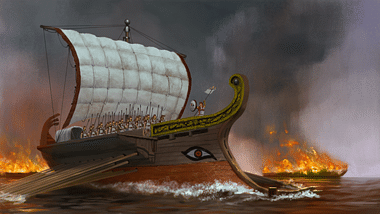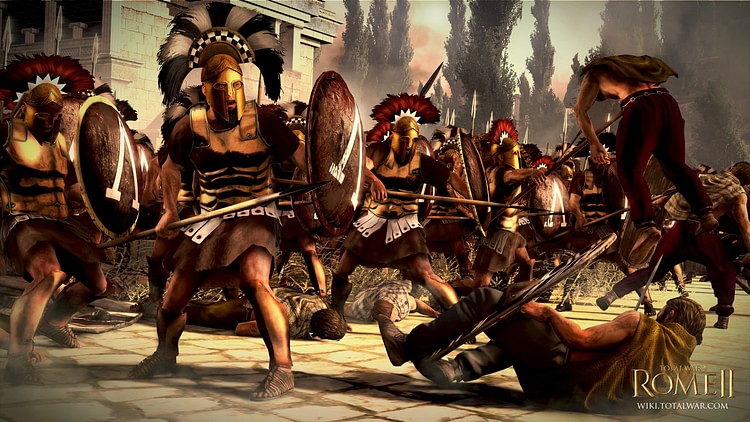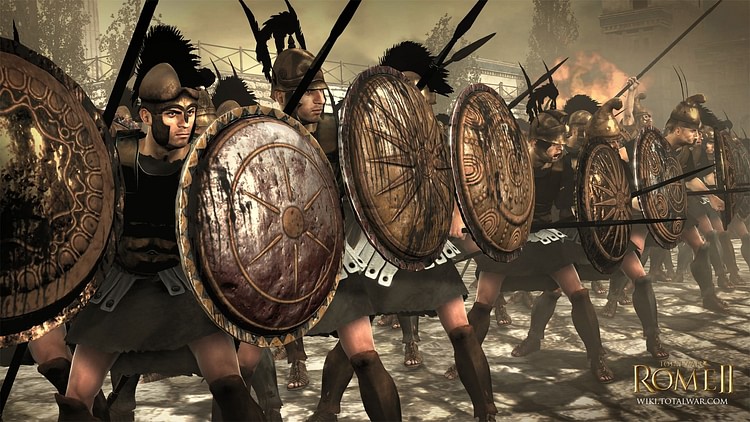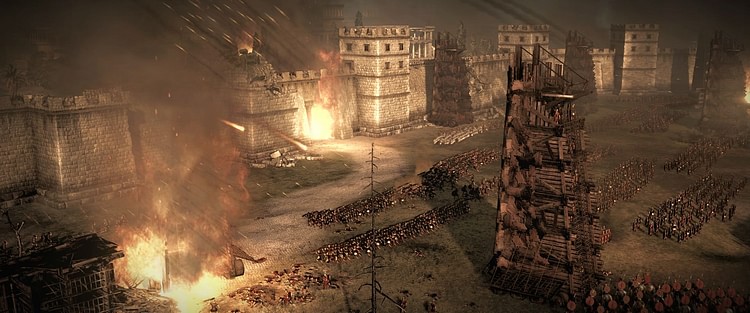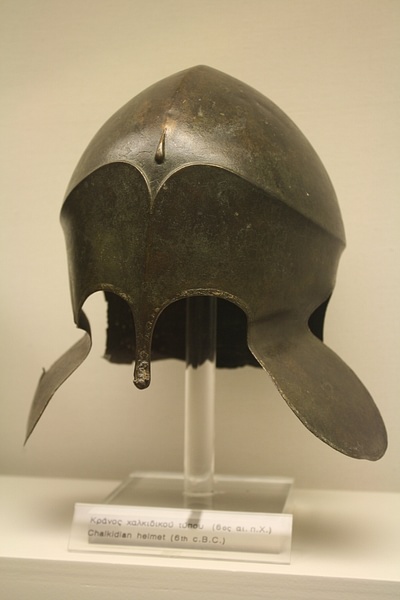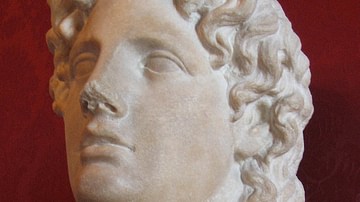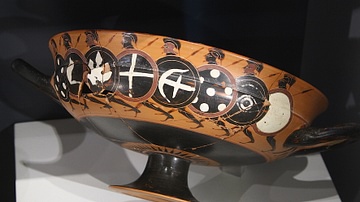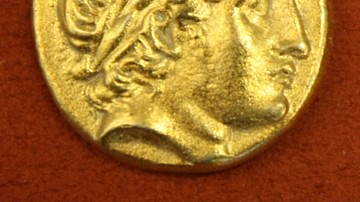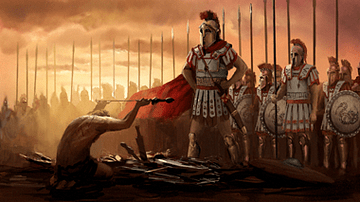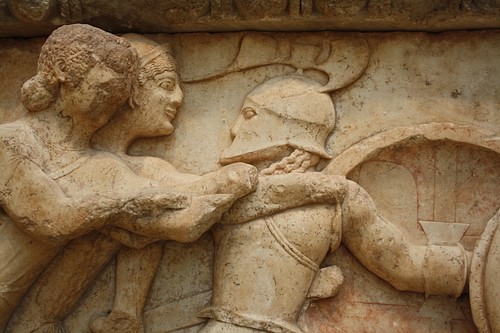
In the ancient Greek world, warfare was seen as a necessary evil of the human condition. Whether it be small frontier skirmishes between neighbouring city-states, lengthy city-sieges, civil wars, or large-scale battles between multi-alliance blocks on land and sea, the vast rewards of war could outweigh the costs in material and lives. Whilst there were long periods of peace and many examples of friendly alliances, the powerful motives of territorial expansion, war booty, revenge, honour, and the defence of liberty ensured that throughout the Archaic and Classical periods the Greeks were regularly engaged in warfare both at home and abroad.
City-State Rivalries
Evolving from armed bands led by a warrior leader, city militia of part-time soldiers, providing their own equipment and perhaps including all the citizens of the city-state or polis, began to move warfare away from the control of private individuals and into the realm of the state. Assemblies or groups of elite citizens sanctioned war, and generals (strategoi) came to be accountable for their actions and were often elected for fixed terms or specific military operations.
In the early stages of Greek Warfare in the Archaic period, training was haphazard and even weapons could be makeshift, although soldiers were usually paid, if only so that they could meet their daily needs. There were no uniforms or insignia and as soon as the conflict was over the soldiers would return to their farms. By the 5th century BCE the military prowess of Sparta provided a model for all other states to follow. With their professional and well-trained full-time army dressed in red cloaks and carrying shields emblazoned with the letter lambda (for Lacedaemonians), the Spartans showed what professionalism in warfare could achieve.
![Greek Hoplites [Artist's Impression]](https://www.worldhistory.org/img/r/p/500x600/4820.png?v=1653899588)
Many states such as Athens, Argos, Thebes, and Syracuse began to maintain a small professional force (logades or epilektoi) which could be augmented by the main citizen body if necessary. Armies became more cosmopolitan with the inclusion of resident foreigners, slaves, mercenaries, and neighbouring allies (either voluntary or through compulsion in the case of Sparta's perioikoi). Warfare moved away from one-off battles fought in a few hours to long-drawn-out conflicts which could last for years, the most important being the Persian Wars (first half of the 5th century BCE), the Peloponnesian Wars (459-446 & 431-404 BCE), and the Corinthian Wars (394-386 BCE).
The Hoplite Phalanx
The mainstay of any Greek army was the hoplite. His full panoply was a long spear, short sword, and circular bronze shield and he was further protected, if he could afford it, by a bronze helmet (with inner padding for comfort), bronze breastplate, greaves for the legs and finally, ankle guards. Fighting was at close-quarters, bloody, and lethal. This type of warfare was the perfect opportunity for the Greek warrior to display his manliness (andreia) and excellence (aretē) and generals led from the front and by example.
To provide greater mobility in battle the hoplite came to wear lighter armour such as a leather or laminated linen corselet (spolades) and open-faced helmet (pilos). The peltast warrior, armed with short javelins and more lightly-armoured than the hoplite became a mobile and dangerous threat to the slower moving hoplites. Other lighter-armed troops (psiloi) also came to challenge the hoplite dominance of the battlefield. Javelin throwers (akonistai), archers (toxotoi) and slingers (sphendonētai) using stones and lead bullets could harry the enemy with attacks and retreats. Cavalry (hippeis) was also deployed but due to the high costs and difficult terrain of Greece, only in limited numbers e.g., Athens, possessing the largest cavalry force during the Peloponnesian Wars had only 1,000 mounted troops. Decisive and devastating cavalry offensives would have to wait until the Macedonians led by Philip and Alexander in the mid-4th century BCE.
Armies also became more structured, split into separate units with hierarchies of command. The lochoi was the basic unit of the phalanx - a line of well-armed and well-armoured hoplite soldiers usually eight to twelve men deep which attacked as a tight group. In Athens, the lochos was led by a captain (lochagos) and these combined to form one of ten regiments (taxeis) each led by a taxiarchos. A similar organisation applied to the armies of Corinth, Argos, and Megara. In 5th-century BCE Sparta, the basic element was the enomotiai (platoon) of 32 men. Four of these made up a pentekostys (company) of 128 men. Four of these made up a lochos (regiment) of 512 men. A Spartan army usually consisted of five lochoi with separate units of non-citizen militia - perioikoi. Units might also be divided by age or speciality in weaponry and, as warfare became more strategic, these units would operate more independently, responding to trumpet calls or other such signals mid-battle.
War At Sea: The Trireme
Some states such as Athens, Aegina, Corinth, and Rhodes amassed fleets of warships, most commonly the trireme, which could allow these states to forge lucrative trading partnerships and deposit troops on foreign territory and so establish and protect colonies. They could even block enemy harbours and launch amphibious landings. The biggest fleet was at Athens, which could amass up to 200 triremes at its peak, and which allowed the city to build and maintain a Mediterranean-wide empire.
The trireme was a light wooden ship, highly manoeuvrable and fitted with a bronze battering ram at the bow which could disable enemy vessels. 35 metres long and with a 5-metre beam, some 170 rowers (thetes - drawn from the poorer classes) sitting on three levels could propel the ship up to a speed of 9 knots. Also on board were small contingents of hoplites and archers, but the principal tactic in naval warfare was ramming not boarding. Able commanders arranged their fleets in a long front so that it was difficult for the enemy to pass behind (periplous) and ensure his ships were sufficiently close to prevent the enemy going through a gap (diekplous). Perhaps the most famous naval battle was Salamis in 480 BCE when the Athenians were victorious against the invading fleet of Xerxes.
However, the trireme had disadvantages in that there was no room for sleeping quarters and so ships had to be drydocked each night, which also prevented the wood becoming waterlogged. They were also fantastically expensive to produce and maintain; indeed the trireme was indicative that now warfare had become an expensive concern of the state, even if rich private citizens were made to fund most of the expense.
Battle Strategies
The first strategy was actually employed before any fighting took place at all. Religion and ritual were important features of Greek life, and before embarking on a campaign, the will of the gods had to be determined. This was done through the consultation of oracles such as that of Apollo at Delphi and through animal sacrifices (sphagia) where a professional diviner (manteis) read omens (ta hiera), especially from the liver of the victim and any unfavourable signs could certainly delay the battle. Also, at least for some states like Sparta, fighting could be prohibited on certain occasions such as religious festivals and for all states during the great Panhellenic games (especially those at Olympia).
When all of these rituals were out of the way, fighting could commence but even then it was routine to patiently wait for the enemy to assemble on a suitable plain nearby. Songs were sung (the paian - a hymn to Apollo) and both sides would advance to meet each other. However, this gentlemanly approach in time gave way to more subtle battle arrangements where surprise and strategy came to the fore. What is more, conflicts also became more diverse in the Classical period with sieges and ambushes, and urban fighting becoming more common, for example at Solygeia in 425 BCE when Athenian and Corinthian hoplites fought house to house.
Strategies and deception, the 'thieves of war' (klemmata), as the Greeks called them, were employed by the more able and daring commanders. The most successful strategy on the ancient battlefield was using hoplites in a tight formation called the phalanx. Each man protected both himself and partially his neighbour with his large circular shield, carried on his left arm. Moving in unison the phalanx could push and attack the enemy whilst minimising each man's exposure. Usually eight to twelve men deep and providing the maximum front possible to minimise the risk of being outflanked, the phalanx became a regular feature of the better-trained armies, particularly the Spartans. Thermopylae in 480 BCE and Plataea in 479 BCE were battles where the hoplite phalanx proved devastatingly effective.
At the Battle of Leuctra in 371 BCE, Theban general Epaminondas greatly strengthened the left flank of his phalanx to about 50 men deep which meant he could smash the right flank of the opposing Spartan phalanx, a tactic he used again with great success at Mantineia in 362 BCE. Epaminondas also mixed lighter armed troops and cavalry to work at the flanks of his phalanx and harry the enemy. Hoplites responded to these developments in tactics with new formations such as the defensive square (plaision), used to great effect (and not only in defence) by Spartan general Brasidas in 423 BCE against the Lyncestians and again by the Athenians in Sicily in 413 BCE. However, the era of heavily armoured hoplites neatly arranged in two files and slashing away at each other in a fixed battle was over. More mobile and multi-weapon warfare now became the norm. Cavalry and soldiers who could throw missiles might not win battles outright but they could dramatically affect the outcome of a battle and without them the hoplites could become hopelessly exposed.
Siege Warfare
From an early stage, most Greek city-states had a fortified acropolis (Sparta and Elis being notable exceptions) to protect the most important religious and civic buildings and provide refuge from attack. However, as warfare became more mobile and moved away from the traditional hoplite battle, cities sought to protect their suburbs with fortification walls. Independent lookout towers in the surrounding countryside and even frontier forts and walls sprang up in response to the increased risk of attacks. Many poleis also built fortifications to create a protective corridor between the city and their harbour, the most famous being the Long Walls which spanned the 7 km between Athens and Piraeus.
Sieges were usually long-drawn-out affairs with the principal strategy being to starve the enemy into submission. Offensive strategies using battering rams and ramps proved largely unsuccessful. However, from the 4th century BCE technical innovations gave the attackers more advantages. Wheeled siege towers, first used by the Carthaginians and copied by Dionysius I of Syracuse against Motya in 397 BCE, bolt-throwing artillery (gastraphetes), stone throwing apparatus (lithoboloi) and even flame-throwers (at Delion in 424 BCE) began a trend for commanders to be more aggressive in siege warfare. However, it was only with the arrival of torsion artillery from 340 BCE, which could propel 15 kg stones over 300 metres, that city walls could now be broken down. Naturally, defenders responded to these new weapons with thicker and stronger walls with convex surfaces to better deflect missiles.
Logistics: Baggage & Supplies
The short duration of conflicts in the Greek world was often because of the poor logistics supplying and maintaining the army in the field. Soldiers were usually expected to provide their own rations (dried fish and barley porridge being most common) and the standard for Athens was three-days' worth. Most hoplites would have been accompanied by a slave acting as a baggage porter (skeuophoroi) carrying the rations in a basket (gylion) along with bedding and a cooking pot. Slaves also acted as attendants to the wounded as only the Spartan army had a dedicated medical officer (iatroi). Fighting was usually in the summer so tents were rarely needed and even food could be pillaged if the fighting was in enemy territory. Towards the end of the Classical Period, armies could be resupplied by ship and larger equipment could be transported using wagons and mules which came under the responsibility of men too old to fight.
Spoils of Victory
War booty, although not always the primary motive for conflict, was certainly a much-needed benefit for the victor which allowed him to pay his troops and justify the expense of the military campaign. Booty could come in the form of territory, money, precious materials, weapons, and armour. The losers, if not executed, could expect to be sold into slavery, the normal fate for the women and children of the losing side. It was typical for 10% of the booty (a dekaten) to be dedicated in thanks to the gods at one of the great religious sanctuaries such as Delphi or Olympia. These sites became veritable treasuries and, effectively, museums of weapons and armour. They also became too tempting a target for more unscrupulous leaders in later times, but still the majority of surviving military material comes from archaeological excavations at these sites.
Important rituals had to be performed following victory which included the recovering of the dead and the setting up of a victory trophy (from tropaion, meaning turning point in the conflict) at the exact place on the battlefield where victory became assured. The trophy could be in the form of captured weapons and armour or an image of Zeus; on occasion memorials to the fallen were also set up. Speeches, festivals, sacrifices and even games could also be held following a victory in the field.
Conclusion
Greek warfare, then, evolved from small bands of local communities fighting for local territory into massive set-piece battles between multi-allied counterparts. War became more professional, more innovative, and more deadly, reaching its zenith with the Macedonian leaders Philip II and Alexander the Great. Learning from the earlier Greek strategies and weapons innovations, they employed better hand weapons such as the long sarissa spear, used better artillery, successfully marshalled diverse troop units with different arms, fully exploited cavalry, and backed all this up with far superior logistics to dominate the battlefield not only in Greece but across vast swathes of Asia and set the pattern for warfare through Hellenistic and into Roman times.
